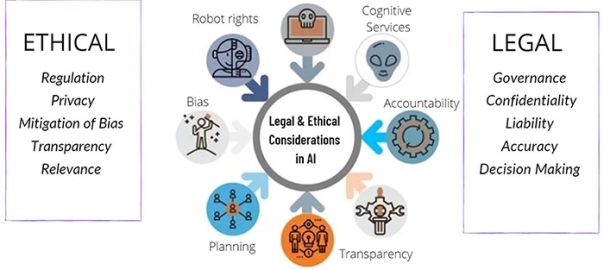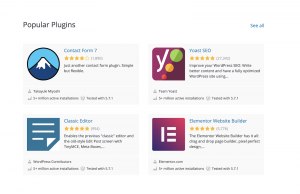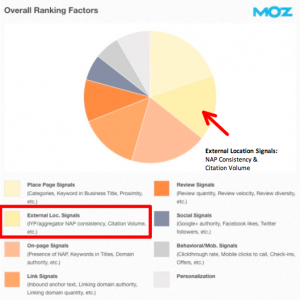Generative AI’s Positive and Negative Impact on In-House Legal Teams

Generative Artificial Intelligence (AI) has become increasingly relevant in various industries such as banking, healthcare, and retail. When these AI capabilities are applied to the legal services domain, it opens up avenues for streamlining mundane tasks and tackling complex challenges with greater speed and precision.
In-house counsel teams could be major beneficiaries leveraging Generative AI technologies for numerous core activities from document drafting to legal research to risk assessment.
This blog looks deeper into the influence of Generative AI on your in-house legal team from improving efficiency in tasks like document review to ensuring data privacy compliance. A comparison between using AI tools versus traditional processes will also be discussed along with ethical implications that must be taken into consideration when adopting this technology.
Enhancing Document Drafting and Reviewing Processes
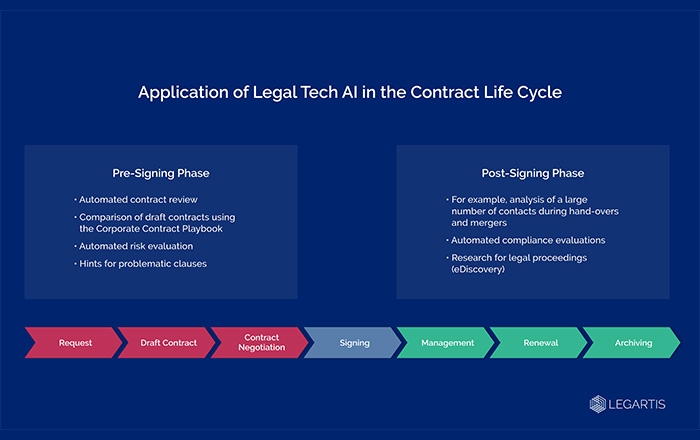
Streamlining contract creation with AI-generated templates
One of the clear benefits of Generative AI’s capabilities is its ability to automate certain tasks associated with document drafting and reviewing.
Leveraging AI-generated templates streamlined through machine learning introduces greater accuracy and consistency in legal documentation, allowing for improved negotiability and even accepted formats for various countries.
By taking over mundane chores, countless hours searching through dozens of rules, regulations, and precedents are saved from manual document review processes.
Ultimately, this drives an overall efficiency gain across teams—combining the human know-how of in-house legal staff with the automation potential of Generative AI powered tools creates a more efficient approach to managing documents in higher volumes more efficiently.
Improving accuracy and consistency in legal documentation
In general, Generative AI has now become a trusted assistant to in-house legal teams, especially when it comes to document drafting and reviewing.
By providing access to AI-powered document templates and automated editing features such as error correction, punctuation fixes and recognition of inconsistent terminology etc., Generative AI eliminates subscription costs while transitioning manual drafting into fully digitalized workflow.
Furthermore, advanced Machine Learning algorithms help generate natural language reasoning for decisions made in transactional documents consistently resulting in more accurate overall synthesizing.
Overall, this provides a solid foundation upon which the in-house legal team could further build its strategic plans for any organization freeing more resources that were used for manual tasks and enabling flexible current time as the practice grows or changes.
Reducing time and effort spent on manual document review
One of the key benefits of introducing Generative AI into legal document drafting and reviewing processes is the time and effort they save when reviewing legal documentation.
By automating much of the process with AI-driven tools, in-house lawyers can focus on more complex aspects of their document reviews that still need our own insights and expertise.
Powerful AI algorithms are also capable of extracting salient points from large blocks of text, making these reviews much more efficient and reducing the amount of time required for manual review tasks.
This can then be bolstered with powerful text analysis capabilities which aid in optimized refinement to produce accurate legal contracts quickly without needing to wade through Menicus’s doctrine within an overly saturated legal speak.
Facilitating Legal Research and Analysis
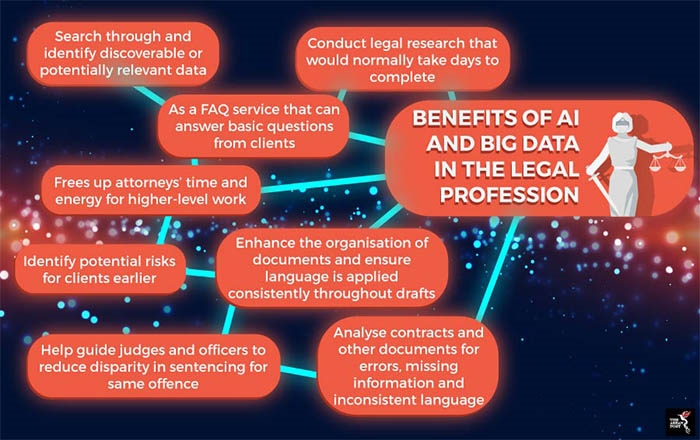
Utilizing AI-powered tools for comprehensive legal research
AI-powered tools are redefining the way in-house counsel attorneys conduct research and analysis to provide accurate, up-to-date information. Improving search capabilities with natural language processing and deep learning enables lawyers to access vast amounts of legal data within limited time period.
AI technology can automatically sift through vast repositories of laws, case decisions and rulings for instances that could potentially support the matter at hand – drastically reducing manual labour and examining manours legal documents.
The AI can assist attorneys in finding relevant information quickly with curated knowledge databases specifically built for the legal industry. AI technology can also automate redundant tasks like tracking updates on regulations and state policy changes – boosting unprecedented accuracy for inordinate time efficiencies.
Identifying relevant case laws and precedents efficiently
AI is helping in-house legal teams to conduct comprehensive legal research and identify relevant case laws and precedents more efficiently.
AI-enabled tools can reduce the time required to sift through massive troves of data by quickly distilling connections between specific cases with precision and accuracy.
In particular, Natural Language Processing (NLP) further expedites the process as it enables AI to “interpret” content just as a human would understand it, allowing lawyers to navigate archives more quickly.
Enhancing data-driven decision-making processes
Data-driven decision-making processes are essential elements of strategic legal and business decisions. Generative AI can provide the analysis needed to make important determinations with increased accuracy, faster completion times, and higher confidence levels.
With access to advanced features like natural language processing and machine learning, Generative AI can sift through large amounts of text documents quickly to identify issues and apply relevant regulatory context.
Not only that, but by utilizing analytical data visualization protocols in legal-specific information sets AI can find patterns and corresponding contextual insights that might have otherwise gone unnoticed.
Mitigating Risk and Compliance Challenges
Identifying potential risks and compliance gaps through AI analysis
Risk and compliance constitute major issues any business needs to address. Therefore, leveraging Generative AI for identifying risks and potential compliance gaps ensures in-house legal teams remain compliant with the ever-changing regulatory landscape.
AI-powered solutions are capable of deep dive analysis that can thoroughly inspect even large volumes of documentation within a short span of time to locate unusual behavior that could indicate a problem.
Real-time monitoring of regulatory changes and updates
Real-time monitoring of regulatory changes and updates is becoming increasingly critical for in-house counsel teams due to the volatile changes in legal regulations.
Generative AI helps by alerting legal professionals of any new rules or policy amendments that they need to be aware of and enables them to take proactive measures to prepare their organizations if needed.
Additionally, AI can utilize large amounts of data efficiently and quickly gather relevant pieces of information that would otherwise a lot longer time with manual processes. This can help avoid non-compliance-related risk issues as well as fines resulting from incorrect or obsolete legal documentation.
Strengthening adherence to legal and ethical standards
AI-powered risk assessment and compliance monitoring tools can help in-house counsel teams reinforce adherence to legal and ethical standards.
These tools utilize advanced analytics and artificial intelligence capabilities to analyze, interpret, and utilize volunteered and existing data in order to identify potential risk mitigation strategies.
Apart from continuous evaluation of changes in regulations, these AI solutions also assist in targeted surveillance of relevant document processes that would enable earlier detection of any compliances failings.
By automating mundane compliance tasks as problem prevention rather than costly rectification, Generative AI can significantly reduce legal risks for corporate entities enormously.
Empowering Data Privacy and Security Measures
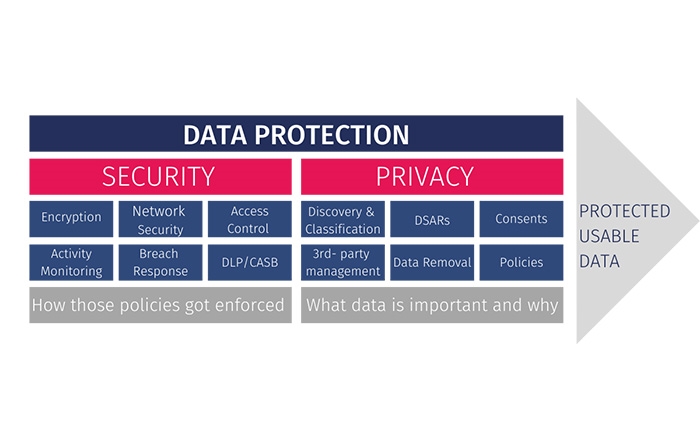
Leveraging AI for robust data privacy and security protocols
As data protection, privacy, and security continue to be of paramount importance for organizations in the digital era, leveraging generative AI can prove beneficial in strengthening these measures.
AI-powered solutions assist in managing the complexity of data protection regulation along with instilling comprehensive risk-detection capability.
Simultaneously these capabilities can optimize access control processes for financial information, implement streamlined authentication systems and detect anomalous activities performing regular security checks.
Enhancing contract and data management with AI-driven solutions
AI-driven solutions can enhance contract and data management drastically in improving the security of law firm documents.
AI technologies such as natural language processing and document analysis are being increasingly used to understand the relationships among people, entities, assets, clauses, and data that aid in the secure management of legal agreements.
Furthermore, AI-backed automated reviews can be helpful in understanding the rights associated with such contracts and notifying lawyers of breaches in real-time.
This process can immensely increase visibility for tremendous upside gains as any change or breach is immidiately noticed and prompt action from entities abides with a minimized security risk.
Safeguarding sensitive information effectively
Data privacy and security are of paramount importance in today’s environment. Generative AI offers a wealth of opportunities to enhance the existing security measures in place for in-house legal teams.
By utilizing its predictive algorithms and crunching large datasets, AI can identify patterns in existing data entries, find potential gaps, detect unauthorized activities, monitor individuals’ access rights and more.
Thanks to its automated nature, such tools can help safeguard sensitive information with accuracy that would be hard to achieve otherwise – streamlining the process for improved efficiency overall.
Addressing Ethical and Legal Implications of AI Usage
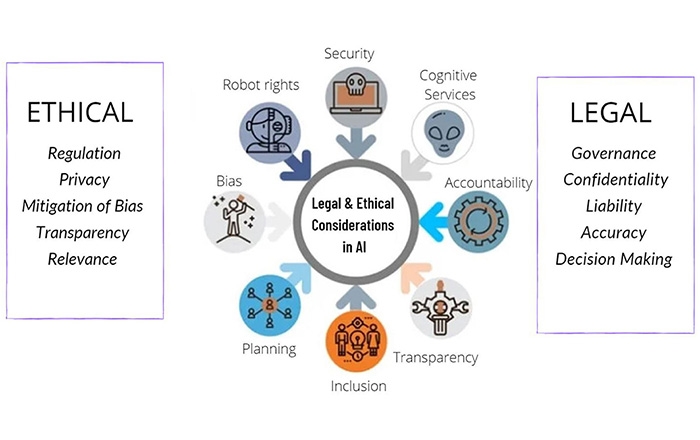
Exploring ethical considerations in Generative AI adoption
As AI technology continues to rapidly advance, it is important for in-house legal teams to consider and understand ethical considerations when implementing generative AI.
Generative AI applications involve higher levels of autonomy in detecting and generating information which intensifies the need for careful study into the moral values behind their usage.
It is up to human experts to understand how decisions made by algorithmic systems could create ethical dilemmas thus bringing forth considerable legal responsibilities that enterprises need to be aware of.
Guiding principles must be established regarding fair evaluation measures and prevent bias from forming within implementable code, as difficult as these tasks may seem with available resources.
Understanding legal responsibilities and liabilities
Legal teams must consider the varied complexities surrounding the ethical and legal implications of Generative AI adoption. To that effect, understanding their legal responsibilities and liabilities when using AI technology is an essential part of successful integration.
Documenting any issues or implications regarding liability should correspond with current regulatory frameworks guiding producers and providers of automated outcomes or solutions in order to protect your team from conflicts related to content copyright, intellectual property, accuracy, security, etc.
Overall, it’s important to thoroughly vet and fully understand applicable legal parameters behind deploying Generative AI before adoption.
Developing guidelines for responsible AI utilization
In order to use AI ethically and responsibly in the legal landscape, it is crucial for organizations to develop controls and guidelines around their AI initiatives.
Organizations should create processes that aim to promote legal ethics such as reasonable reliance, data minimization strategies, and integration of explorable journalism documentation systems.
Additionally, firms should address data collection requirements as well as integrate functional verification rules throughout their projects. With these iterations, companies will be better equipped to enforce core elements of responsible AI in lawful practice spaces.
Training and Upskilling of In-House Legal Teams
Preparing legal professionals for AI integration in their workflows
Preparing legal professionals to anticipate and embrace AI integration is a critical step in the successful transition of in-house counsel teams to ever-advancing technology-driven pathways.
Increased awareness of AI capabilities, more frequent application of digital tools, and adoption of technical integrations into workflows – all these are necessary elements for developing the human capacity required enabling AI technology.
Professional training offerings can focus on core education regarding AI trends, technologies and best practices that should equip existing practitioners with the essential skillset applicable across a broad spectrum of industry deployments.
Fostering a culture of continuous learning and development
Developing a culture of continuous learning and development among in-house legal teams is crucial when breaking into a market powered by Generative AI.
By providing courses and training to help prepare professional legal talent for the digital transformation in the industry, these teams can expand the upside of their individual and collective capabilities.
Initiating conversations surrounding legal adeptness for cooperation with newer technologies requires devotion from each team member, enabled by ample educational opportunities motivated by senior members.
Opening up dialogues regarding related educational products allows revolutionization full of opposition in progressive initiatives just as exploration can break through any technological power movement regulations placed on access across utilities regardless of societal standard practice.
Encouraging collaboration between AI and human legal expertise
Organizations that adopt Generative AI technologies must invest in securing the long-term success of their investment.
This includes preparing the existing in-house legal teams for utilizing AI capabilities effectively and creating a culture of continuous learning around it Professional clarity on responsibilities and liabilities are critical.
By allowing both human and AI legal expertise to collaborate, legal departments will move closer to gaining efficient analytical outcomes.
Otherwise, risks pouring out from cognitive bias from a single perspective might be realized that could cost organizations bottlenecks along with profitability.
Conclusion
In conclusion, Generative AI technologies are providing not only unparalleled efficiency and accuracy to legal workflows but also opening up possibilities of ethical futures where muscled collaborations between human expertise and AI capabilities produce smart solutions with profound potential in onboarding brighter fairer worlds.
Beyond highly advanced document crafting and thorough research pursuits, in-house legal teams can now extend their horizons view risk management as well as diligently overlook the sensible data privacy protocols.
Business players should especially have great motivations to formulate and to deploy strategic training programs efficaciously training staff continuously adhering responsibly towards continuously advocated legislative modifications.
The post Generative AI’s Positive and Negative Impact on In-House Legal Teams appeared first on ReadWrite.
(9)
